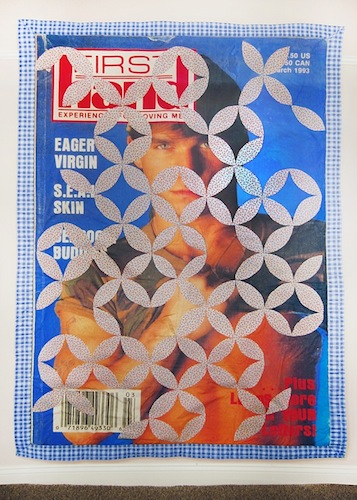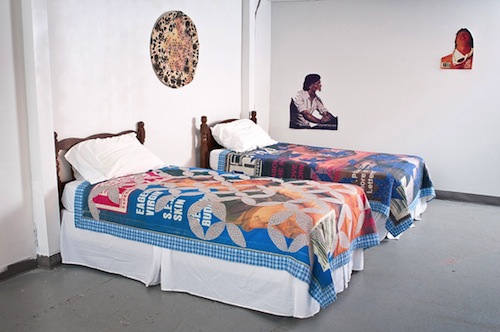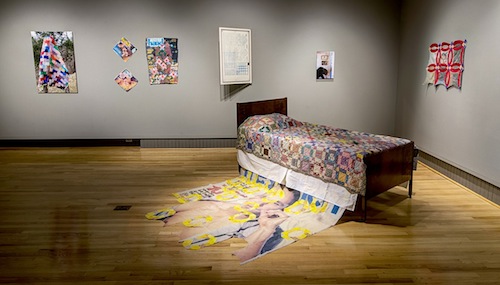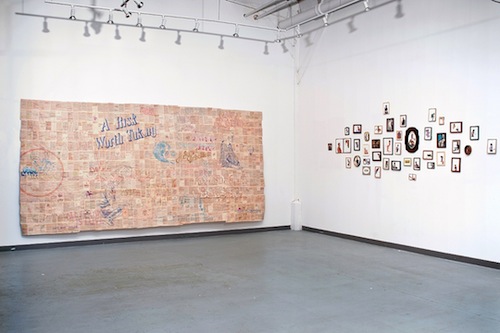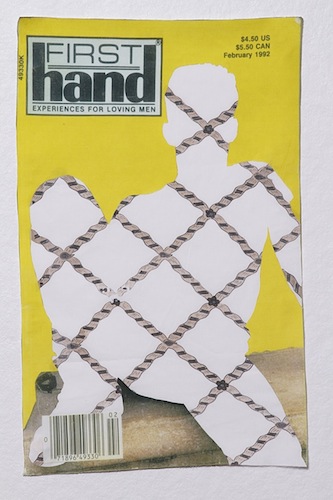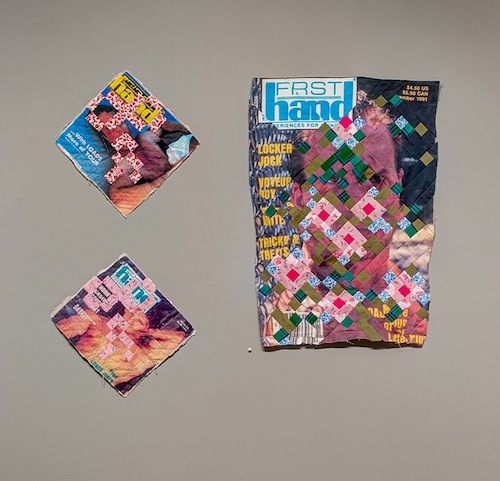Aaron McIntosh is a Baltimore based artist from Tennessee. He received his BFA from the Appalachian Center for Craft, Tennessee Technological University in Smithville, Tennessee in 2006 and his MFA from Virginia Commonwealth University in Richmond, Virginia in 2010. He has taught at Virginia Commonwealth University, James Madison University and currently teaches at the Maryland Institute College of Art as full time faculty member of the Fiber department. He has exhibited across the country as well as served as a juror, curator and visiting lecturing artist. He has received numerous awards, including a 2013 Maryland State Arts Council Individual Artist Grant and he has been featured in American Craft Magazine.
McIntosh stands out amongst fiber artists, not just because he is male but because he works with found images from source materials ranging from vintage pulp fiction to online media. His work explores the concept of desire and sexual identities and experiences. Personal narrative meets public media as he repurposes the images to allow new stories and ideas to evolve.
Despite its personal subject matter, McIntosh’s work remains inviting and accessible. Though the content at times can produce a sense of voyeurism, McIntosh balances this out with craftsmanship of hand-cut paper and quilting, which allude to familial ties and comfort. His personal revelations add to the work immensely, bringing a queer male perspective to what is traditionally thought of as a female dominated practice, from a refreshing, unique viewpoint. As a fiber artist myself, I find his work easy to get lost in, full of small details that make up a surreal, yet complete world.
KS: Just a little background information – Where are you from? Where did you go to school and what was your major and what degree did you receive?
AM: I’m from east Tennessee, Appalachia, and I started school at Virginia Commonwealth University, and was there for a year. I took a year off of school to work on a farm. I wanted to work on a commune, using textiles to make a living, and thus went to a traditional craft school to learn weaving, surface design and other techniques. This is how I ended up at the Appalachian Center for Craft for three years. I eventually realized I was much more interested in content-based work and not craft-for-crafts-sake.
KS: How did you get involved in fiber art? What do you like about the medium?
AM: I have always been really interested in cloth, and as a kid very into blankets and quilts grandmothers made me. Grandmothers on both sides were big quiltmakers and known in the community for it. I taught myself to sew when I was ten. Despite the fact that I begged my mom to teach me, she kept putting it off, so I dragged the machine out and taught myself over the summer and have been sewing ever since. I had thought I might want to go into fashion, but I have always been very interested in sculpture and painting. Fiber just kind of ended up being the perfect thing that was in between all of those pursuits.
KS: What made you decide to teach?
AM: One big aspect of why I teach is that I really like the fiber and textiles field, and I like passing on that knowledge to young people. Within fiber there is such a wide range of techniques and materialities, modes of thinking, political responses, body responses, architectural responses.
KS: Where/how do you get your inspiration? What is your process like?
AM: I’m inspired by a wide variety of things, when I have to narrow it down its mostly about domestic space and textiles and print material. I use a lot of vintage print materials, from the 1960s and ’70s all the way up to the 2000s, along with digital images and online media. I am definitely interested in the interactions between domestic objects and our contemporary notions of selfhood, identities and sexualities.
KS: How would you describe your work?
AM: The one liner thing I’ll say is “homo grandma art,” I’m using these pretty old-fashioned methods and materials and imbedding my our queer narrative into those. That being said, the work changes a lot, but that definition kind of sticks.
KS: In my professional practices class we’ve been talking about what it means to be a “successful” art professional. What is your definition of a “successful” artist?
AM: Well, I think one must have a lot of flexibility in this regard. My idea of successful art making is in tandem with a successful whole life. If I was only taking care of an art career and not tending to the other aspects of life that feed me, like socialization, I would inevitably end up making for some very weird work. I think its very important for people to be well rounded. Tending to the other parts of your life is integral to being a successful artist. In the professional context, I think success for me is having an active studio in which a deeply personal critical inquiry is always cultivated.
KS: At what point in your career do you consider yourself to be, and what future plans/goals do you have for yourself and your career?
AM: I try to be always active in the studio. If this is the case, I’m able to not stress as much, and accept that things will come to you. I really believe in being a hard worker. I love this quote from Patti Smith: “You just make your work, you make your work, no matter whatever that is.” You can be struggling and not getting any criticism or praise but you are making your work. That’s a really a core tenant for me. Otherwise, I would be like to be showing a lot more locally, or to be working with a commercial gallerist.
KS: How did you get your career started as an artist? What advice do you have for emerging artists?
AM: I was in two different versions of art school, undergrad at a rural craft school and then grad school, a normal, intense MFA program. I started teaching immediately after school, and now am a teacher and an artist.
My best advice for undergraduates who are contemplating graduate school and careers beyond would be to consider taking a year or more off before another round of school. The time in-between degrees was as educational as either of my degrees! When I finished undergrad I moved to Knoxville, TN, and very immediately got to know the art community there. I ended up renting a studio, which has been another important thing to me–always having a studio and meeting people through that process. Artists must know their community or create it from scratch. You need to know who your connections are when you leave school because those are the people who are going to propel you forward.
KS: What, in your opinion, is the hardest part of being a professional artist? What is the best or most rewarding part of it?
AM: Balance is the hardest part, period. If I weren’t teaching I’d be working some other job to pay the bills…. finding the balance and ways to keep motivating yourself. You have to figure out ways to make your studio exciting and comfortable and the kind of space in which you want to get in there and work. The most rewarding part is when you have the opportunity to share your work, like in an exhibition or sending things out and just hearing back from people and getting peoples’ responses. Hearing from some people that you really are making them think outside of their normal context is personally very rewarding.
KS: What do you do to keep yourself busy and working? How do you keep yourself involved in the local (or larger) art scene?
AM: Always have something you’re working on. I started the Chronicles of Cruising project (doing one cut paper piece every day for one year) in 2011 while I had a bunch of other things on my plate. There will never be enough time if you are genuinely excited by your practice. I have never been perplexed by a conundrum of “no ideas.” I have this big studio notebook with all these ideas that are not even started yet but are projects that I will someday tackle. I have so many ideas, I don’t even know if I’ll make them in a lifetime. Embrace the “slow burn.” Also, so many artists become obsessed with the notion of singular experiences for the work they make. Often, there’s a lot of work and mental effort involved in the making of my work that I’m happy to show it on multiple occasions and in multiple iterations at different venues. I would rather have any of my works from the past 3-4 years being exhibited than sitting in cardboard boxes in my storage unit.
To see more of Aaron McIntosh’s work, check out his website here.
Author Kelsey Schneider currently studies General Fine Arts and Gender Studies at MICA.
*Answers are abbreviated from a voice recording of a conversation/interview.
